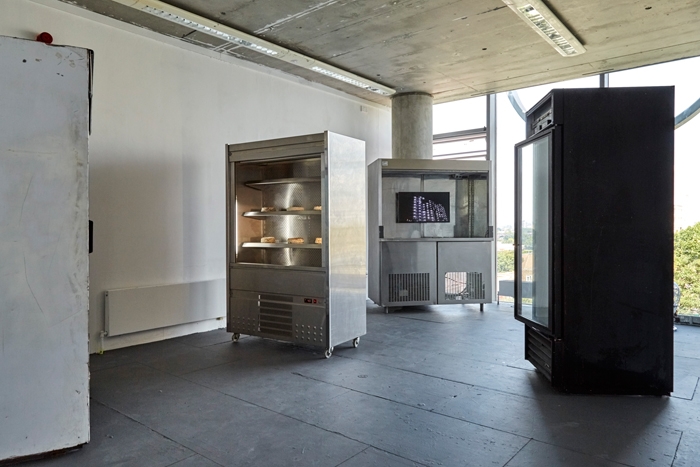During November, Dublin’s most topically on-the-nose exhibition is a display of cheese made from poisonous domestic mould. Stinking up the city’s lab Gallery – a publicly funded space specialising in breakthrough shows by young artists – these deviant artisanal delicacies are the work of Irish conceptual trickster and recent Goldsmiths MA graduate Avril Corroon. For the past year, Corroon has been assiduously scraping mould samples from the walls and ceilings of shabby rented flats and grimy workplaces in both London and Dublin, compiling a rich collection of fungal spores that are then used as the active bacterial agents in a range of painstakingly produced, but dangerously inedible, cheese varieties. Included in the list of ingredients for each neatly completed wheel of toxic fromage (titled, collectively, Spoiled Spores, 2019) is the ridiculous rental cost or shitty salary associated with whichever dingy environment Corroon used as her mould-mine. Her pitch is cookery plus critique, Hans Haacke does The Great British Bake Off. Tainting these outwardly appealing craft products – speciality cheese being, maybe, the defining consumer emblem of pleased-with-itself, middle-class good taste – are noxious traces of overpriced big-city living and unhealthy, low-income labouring. As a ripe take on millennial discontents – the struggle, simply, to access adequate means, to source decent accommodation – Corroon’s exhibition is, thus, uniquely pungent.
Corroon’s subversive cheese-production began in London, but it has further matured back home in Dublin – where, right now, the problem of finding a home is especially acute. The postcrash recovery has led, once again, to crazy property prices, rocketing rents. Small-scale landlords privilege Airbnb weekenders over longer-term tenants. Largescale developers maximise profits by building high-density student housing, dodging the planning constraints and rent controls associated with urgently needed, socially integrated residential schemes. Other property investors – as if in some strange, unwritten J.G. Ballard story – seem committed to constructing an entire city of hotels: selling visions of vibrant urban areas, now emptied out of inconvenient local communities. Every day there are more and more places to stay in Dublin, but fewer and fewer places to live. (It remains a dire irony that the leading website for hopeful house- hunting in Ireland is ‘daft.ie’.)
If the primary issue is a severe housing shortage, a secondary concern is an increasing lack of cultural accommodation. As in London, a boom for developers can mean bust for independent venues – and goodbye to alternative art spaces. Some, such as Pallas Projects – a valiant, artist-run studio-and-gallery initiative – have soldiered on, holding their ground in the face of aggressive gentrification, or touristification, in their immediate neighbourhood. (Dubliner Jonathan Mayhew’s recent Pallas exhibition, a series of shy sculptural tributes to artist-heroes such as Scott Walker and Felix Gonzalez-Torres, proposed artful delicacy as a defence against crude worldly pressures, aspiring, as an accompanying statement declared, to ‘escape this reality by offering a more poetic one in its place’.) Several stalwart commercial galleries have also maintained or enhanced their position over recent years: the Kerlin’s classy minimalist haven remains the city’s most perfect bespoke art space; Mother’s Tankstation’s Dublin base is modest, but their reputational rise has been meteoric; Kevin Kavanagh’s city-centre gallery continues to be a locally trusted resource for new directions in painting; Green on Red’s sizeable docklands showroom hosts a strong, eclectic mix of exhibitions; Oonagh Young’s compact shopfront unit stages – every now and then, whenever the need arises – dependably high-quality, low-key projects.
Art’s 3d actuality, and our embodied excitement or discomfort in its unpredictable company, has become a secondary consideration
Notably, though, the latest gallery to establish itself in Dublin has, perhaps wisely, escaped the city’s space race. Berlin Opticians, a new venture coordinated by Polish-born curator Marysia Wieckiewicz-Carroll, begins life with no fixed abode and with only one foot in the real world – its strategic shtick being a nonprecious attitude to online presentation. Wieckiewicz-Carroll has assembled an impressive roster of ten youngish artists, working in a range of characterful styles – from Sven Sandberg’s exquisitely spooky figurative paintings to Barbara Knezevic’s bio-techno-spiritual installations. The gallery plan, so far, has been to showcase artists in individual six-week displays, the majority of which are staged for documentation in actual architectural environments, but only made available for online viewing via the gallery website; from time to time, there will be complementary forays into customary modes of real-life exhibition-making, each one occurring in a different location. Social-media circulation is, therefore, a priority – outweighing the routine need for closeup artistic encounters. Those of us with memories of the twentieth century will recognise, of course, clear downsides to this approach: the elegance or awkwardness of art’s 3d actuality, and our embodied excitement or discomfort in its unpredictable company, become secondary considerations; two-dimensional presence, and promotional allure, trump experiential complexity. But in a city, and a time, when securing long-term space for art – on a startup, restricted-means basis – has become a near-impossible commitment, who’s to say that this virtual, nomadic model won’t guarantee a more effective boost for the artists involved?
In titling her elusive gallery, Wieckiewicz-Carroll borrowed the brand name of a family business that had quietly thrived in the centre of Dublin for decades but that, quite recently, ceased trading. As such, the name ‘Berlin Opticians’ – an identity that implicitly proclaims Euro-visual affiliation for Ireland’s artists in the current Brexistentialist era – is employed as a way of honouring endurance and longevity in a specific setting. Yet as she starts out, Wieckiewicz-Carroll is also testing newly nimble styles of sticking around. Dublin is, at present, the Eurozone’s most expensive city – beating Paris and Milan to that dubious accolade – and in this financially oppressive context, Berlin Opticians has been set up without the need to settle down: avoiding rental burdens, repeatedly shifting location, favouring virtual distribution. For now, at least, with options ever more limited, restlessness means resistance.
This article originally appeared in the November 2019 issue of ArtReview
